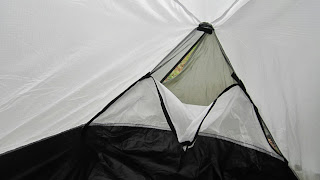I am not and never will be an ultralight backpacker. I like to bring things like a 2 person tent and camp shoes for example, things that would make ultralighters cringe. I carry 13 to 15 pounds in the summer, hideous weights I know. I also hate having weight on my shoulders and I like a pack with functional load lifters. Of course to actually have functional load lifters the frame must terminate above your shoulders which rules out most ultralight backpacks and many packs in general since I am quite tall.
One day I was reading a review of a new backpack on BackpackingLight.com (BPL review) the Seekoutside Evolution. What was interesting was that it was a 4000+ cubic inch pack that weighted less than 4 pounds and had no functional limitation on how much weight it could carry. It was originally developed for hunters and heavy loads but it is lighter than many mainstream internal frame packs. More over it had an interesting suspension and belt as it was an external frame. But one thing stuck out when the reviewer said it would be a good pack for people who don't like traditional, internal frame, lumber pad packs. By this I mean a pack where the stays or structural elements terminate in the lumbar area so that the small of your back carries the burden of the weight. I never really found these packs comfortable as even with moderate loads they irritated my back after a while. I was even more intrigued when I saw you could adjust the frame height so you could get real load lifter action, something hard when you are my height.
 |
| Side view of the Unaweep pack |
The Unaweep is an external frame backpack but this is not your fathers external frame. Unlike the classic Kelty external frames this is as body hugging and stable as any internal frame pack. The frame consists of a U-shaped frame that is narrower at the top than the bottom. It is curved much like the stays of an internal frame pack. The height of the frame can be adjusted by adding or removing frame extenders. It ships with 2 inch extenders but I use it with the 4 inch ones because of my longer torso. The unique feature of the frame is that it is actually two pieces that join at the bottom and the frame can articulate so it doesn't feel like a stiff external frame pack of old.
The packbag (which comes in a 3900 or 4800 cubic inch size) is a simply affair which a roll top closure and two water bottle pockets. It hangs from the top of the frame and has attachment points around the frame to connect it. There is no framesheet so a little bit of care must be taken when packing so things don't poke you in the back. The whole pack in general is spartan and simple, nothing is wasted and there are no frivolous features to add weight. Every piece has an important function.
 |
| Notice how the frame literally hangs from the hipbelt |
 |
| Back of the Unaweep |
 |
| From of the Unawep, the orange is the talon compression panel |
 |
| One of the pockets on the talon |
 |
| Frame extenders these cam be used to adjust the frame height beyond the base frame. Seekoutside sells 2 and 4 inch extenders although they can be cut if you wanted 3 inch ones for example. |
 |
| The harness height can be adjust simply by sliding it up or down by loosening or tightening the buckle |
I've used the Unaweep now on the following trips in the last 6 months with pack weights from about 20 pounds to the upper 30s:
70 miles in Glacier National Park
25 miles on the Mid State Trail in Pennsylvania
An easy backpack trip in the Grayson Highlands. This trip saw all day rain as we hiked to the place we would be camping for 2 nights. Everything inside the pack stayed dry. I had no pack cover and this experience showed that it is not necessary with this pack. I also used it as a daypack on this trip and it worked great for that thanks to the compression
A 23 miles hike in the Massunuttens of Virginia
A 35 miles hike on the AT in Northern Virginia
A 15 miles hike on the Standing Stone Trail in Pennsylvania
A 11 mile hike on the Tuscarora Trail in the Sleepy Creek area of WV
I've gotten a pretty good sample size of use with the pack and for me this is ultimate pack. It can be adjusted to fit perfectly. It is big enough for winter but compresses small enough to use for summer. The VX material is outstanding in the rain. Finally I'll say it again. This is the most comfortable pack I have ever used, by leaps and bounds. I don't foresee using another pack for a long time.
--------------------------------------------------------------------------------------------
A word on ordering from seekoutside. They offer the packbags in several sizes and materials, as well as several styles of the Talon. I would take some time to understand the options before ordering.
http://store.seekoutside.com/



































